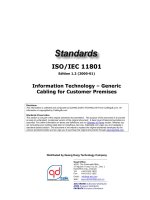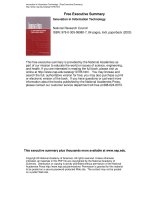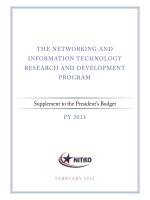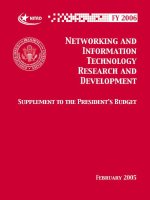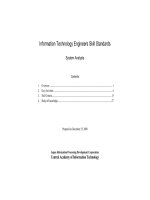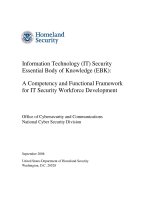Fundamental Information Technology Engineer Examination (Level 2)
Bạn đang xem bản rút gọn của tài liệu. Xem và tải ngay bản đầy đủ của tài liệu tại đây (1.16 MB, 130 trang )
ITPEC-2009-TOKYO-12b
■ Information Technology Engineers Examination
Fundamental Information Technology
Engineer Examination
(Level 2)
Syllabus
— Details of Knowledge and Skills Required for
the Information Technology Engineers Examination —
Version 1.0
October 27, 2008
Corporate names or product names used in this syllabus are trademarks or registered trademarks of each company.
® and TM are not used in the syllabus.
Copyright(c) Information-technology Promotion Agency, Japan. All rights reserved 2008
CONTENTS
■ INTRODUCTION .........................................................................................................................................................1
■ CONFIGURATION OF THE SYLLABUS ...................................................................................................................1
◆TECHNOLOGY◆
MAJOR CATEGORY 1: BASIC THEORY
MIDDLE CATEGORY 1: BASIC THEORY ................................................................................................................2
1.
2.
3.
4.
5.
Discrete mathematics .........................................................................................................................2
Applied mathematics..........................................................................................................................3
Theory of information ........................................................................................................................4
Theory of communications.................................................................................................................5
Theory of measurement and control....................................................................................................6
MIDDLE CATEGORY 2: ALGORITHM AND PROGRAMMING.............................................................................8
1.
2.
3.
4.
5.
Data structure ....................................................................................................................................8
Algorithm ..........................................................................................................................................8
Programming .....................................................................................................................................9
Programming languages...................................................................................................................10
Other languages ...............................................................................................................................17
MAJOR CATEGORY 2: COMPUTER SYSTEM
MIDDLE CATEGORY 3: COMPUTER COMPONENT ...........................................................................................19
1.
2.
3.
4.
5.
Processor .........................................................................................................................................19
Memory...........................................................................................................................................21
Bus..................................................................................................................................................22
Input/output interface .......................................................................................................................22
Input/output device ..........................................................................................................................23
MIDDLE CATEGORY 4: SYSTEM COMPONENT..................................................................................................25
1.
2.
System configuration .......................................................................................................................25
System evaluation indexes ...............................................................................................................26
MIDDLE CATEGORY 5: SOFTWARE......................................................................................................................28
1.
2.
3.
4.
5.
Operating system .............................................................................................................................28
Middleware......................................................................................................................................30
File system ......................................................................................................................................31
Development tools ...........................................................................................................................32
Open source software.......................................................................................................................32
MIDDLE CATEGORY 6: HARDWARE ....................................................................................................................34
1.
Hardware .........................................................................................................................................34
MAJOR CATEGORY 3: TECHNOLOGY ELEMENT
MIDDLE CATEGORY 7: HUMAN INTERFACE .....................................................................................................35
1.
2.
Human interface technology.............................................................................................................35
Interface design................................................................................................................................35
MIDDLE CATEGORY 8: MULTIMEDIA..................................................................................................................37
1.
2.
Multimedia technology ....................................................................................................................37
Multimedia application....................................................................................................................38
MIDDLE CATEGORY 9: DATABASE.......................................................................................................................39
1.
2.
3.
4.
5.
Database architecture .......................................................................................................................39
Database design ...............................................................................................................................40
Data manipulation............................................................................................................................41
Transaction processing .....................................................................................................................42
Database application ........................................................................................................................43
MIDDLE CATEGORY 10: NETWORK.....................................................................................................................44
1.
2.
3.
Network architecture........................................................................................................................44
Data communication and control ......................................................................................................45
Communications protocols ...............................................................................................................46
-iCopyright(c) Information-technology Promotion Agency, Japan. All rights reserved 2008
4.
5.
Network management ......................................................................................................................47
Network application.........................................................................................................................48
MIDDLE CATEGORY 11: SECURITY......................................................................................................................50
1.
2.
3.
4.
5.
Information security.........................................................................................................................50
Information security management ....................................................................................................51
Security technology evaluation.........................................................................................................53
Information security measures..........................................................................................................53
Security implementation technology.................................................................................................54
MAJOR CATEGORY 4: DEVELOPMENT TECHNOLOGY
MIDDLE CATEGORY 12: SYSTEM DEVELOPMENT TECHNOLOGY ...............................................................55
1.
2.
3.
4.
5.
6.
7.
8.
9.
10.
System requirements definition ........................................................................................................55
Systems architecture design..............................................................................................................56
Software requirements definition......................................................................................................57
Software architecture design and software detailed design ................................................................59
Software coding and testing .............................................................................................................63
Software integration and software qualification tests.........................................................................65
System integration and system qualification tests..............................................................................66
Software installation ........................................................................................................................67
Software acceptance.........................................................................................................................67
Software maintenance ......................................................................................................................68
MIDDLE CATEGORY 13: SOFTWARE DEVELOPMENT MANAGEMENT TECHNIQUES...............................71
1.
2.
3.
4.
Development process and methods ...................................................................................................71
Intellectual property application management ...................................................................................72
Development environment management ...........................................................................................73
Configuration management and change control.................................................................................74
◆MANAGEMENT◆
MAJOR CATEGORY 5: PROJECT MANAGEMENT
MIDDLE CATEGORY 14: PROJECT MANAGEMENT ..........................................................................................75
1.
2.
3.
4.
5.
6.
7.
8.
9.
Pproject integration management .....................................................................................................75
Project scope management ...............................................................................................................76
Project time management .................................................................................................................77
Project cost management ..................................................................................................................77
Project quality management .............................................................................................................78
Project human resources management ..............................................................................................79
Project communications management...............................................................................................79
Project risk management ..................................................................................................................80
Project procurement management.....................................................................................................80
MAJOR CATEGORY 6: SERVICE MANAGEMENT
MIDDLE CATEGORY 15: SERVICE MANAGEMENT ...........................................................................................81
1.
2.
3.
4.
5.
6.
Service management ........................................................................................................................81
Operations design and tools..............................................................................................................82
Service support ................................................................................................................................83
Service delivery ...............................................................................................................................85
Service management foundation.......................................................................................................86
Facility management ........................................................................................................................87
MIDDLE CATEGORY 16: SYSTEM AUDIT ................................................................................................................88
1.
2.
System audit ....................................................................................................................................88
Internal control ................................................................................................................................90
-iiCopyright(c) Information-technology Promotion Agency, Japan. All rights reserved 2008
◆STRATEGY◆
MAJOR CATEGORY 7: SYSTEM STRATEGY
MIDDLE CATEGORY 17: SYSTEM STRATEGY ....................................................................................................91
1.
2.
3.
4.
Information systems strategy............................................................................................................91
Business process ..............................................................................................................................94
Solution business .............................................................................................................................95
System utilization promotion and evaluation ....................................................................................95
MIDDLE CATEGORY 18: SYSTEM PLANNING.....................................................................................................97
1.
2.
3.
Computerization planning ................................................................................................................97
Requirements definition ...................................................................................................................97
Procurement planning and implementation .......................................................................................98
MAJOR CATEGORY 8: BUSINESS STRATEGY
MIDDLE CATEGORY 19: BUSINESS STRATEGY MANAGEMENT ..................................................................100
1.
2.
3.
4.
Business strategy techniques .......................................................................................................... 100
Marketing ...................................................................................................................................... 100
Business strategy and goal/evaluation............................................................................................. 101
Business management system......................................................................................................... 102
MIDDLE CATEGORY 20: TECNOLOGICAL STRATEGY MANAGEMENT......................................................103
1.
2.
Planning of technology development strategy ................................................................................. 103
Technology development plan ........................................................................................................ 103
MIDDLE CATEGORY 21: BUSINESS INDUSTRY ................................................................................................ 104
1.
2.
3.
4.
5.
Business system............................................................................................................................. 104
Engineering system........................................................................................................................ 104
e-business ...................................................................................................................................... 105
Consumer appliances ..................................................................................................................... 106
Industrial devices ........................................................................................................................... 107
MAJOR CATEGORY 9: CORPORATE AND LEGAL AFFAIRS
MIDDLE CATEGORY 22: CORPORATE ACTIVITIES ........................................................................................108
1.
2.
3.
Management and organization theory ............................................................................................. 108
OR and IE...................................................................................................................................... 110
Accounting and financial affairs ..................................................................................................... 111
MIDDLE CATEGORY 23: LEGAL AFFAIRS ......................................................................................................... 114
1.
2.
3.
4.
5.
Intellectual property rights ............................................................................................................. 114
Laws on security............................................................................................................................ 115
Laws on labor and transaction ........................................................................................................ 116
Other laws, guidelines, and engineer ethics..................................................................................... 118
Standardization .............................................................................................................................. 121
-iiiCopyright(c) Information-technology Promotion Agency, Japan. All rights reserved 2008
This page is intentionally left blank.
■ Introduction
The syllabus (subtitled as “details of the knowledge and skills required for the Information Technology
Engineers Examination”) for the Fundamental Information Technology Engineer Examination, in which
“the scope of exam questions”1 is described in more detail and the breadth and depth of the knowledge
and skills required for Level 2 are organized and clarified, has been defined and then published here.
It is expected that this syllabus will be used effectively as learning guidelines for examinees who aim to
pass the examination, and also as instructional guidelines in the educational process within companies
and schools.
Please note that the detailed information in this syllabus might be added, changed, or deleted, based on
technology trends and other factors.
■ Configuration of the Syllabus
This syllabus is intended to show the scope of the morning and afternoon questions on the
Fundamental Information Technology Engineer Examination according to the knowledge structure of the
Common Career/Skills Framework2 as shown in the figure below, along with the learning targets and
descriptions on a minor category basis.
Syllabus
Major category
Middle category
Minor category
Goal
Generally indicates what you must learn and to what
extent in each individual item in view of the human
resources models.
[Breadth and depth required]
• “Understanding something”
Learn it as knowledge.
• “Applying something to tasks”
Apply the knowledge learned to rules and principles to
partially solve a problem indepenedently under the
guidance of a supervisor.
• “Learning something so that it can be applied”
With the understanding of the policy of the supervisor,
the examinee will apply the knowledge learned to rules
and principles to solve a problem independently.
Description
1
2
Shows what you must learn in the Goal section along with
sample terms and things to learn.
• Sample terms: Examples of terms and keywords that you
must learn
• Things to lean: Major items that you must learn in preparing
for the afternoon exam questions about
programming languages
“Outline of IT Engineers Examination” 7. Scope on the test
/>Common Carrier/Skills Framework />
-1Copyright(c) Information-technology Promotion Agency, Japan. All rights reserved 2008
Technology
Major Category 1: Basic Theory
Middle Category 1: Basic Theory
1.
Discrete mathematics
[Goal]
Understand the numeric representations handled by the computer, including the radix, radix
conversion, numeric representation, and arithmetic operations and precision so that you can
apply them to your tasks.
Understand the basic rules of and techniques for sets and logical operations so that you can
apply them to your tasks.
(1)
Radix
Understand how the binary, octal, decimal, hexadecimal, and base-n numbers are represented
and how you can convert the radixes between binary and decimal numbers, for example.
(2)
Numeric representation
Understand how negative numbers (complement representation) and fractions are represented.
Sample terms
fixed point number, single-precision floating point number, double-precision
floating point number, mantissa, exponent, BCD (Binary Coded Decimal),
packed decimal number
(3)
Arithmetic operations and their precisions
Understand the arithmetic operations performed by the computer, including addition,
subtraction, multiplication, and division; range of numbers that can be represented; shift
operations; and operation precision (errors and measures against them).
Sample terms
logical shift, arithmetic shift, cancellation of significant digits, loss of
trailing digit, overflow, underflow, single precision, double precision
(4)
Sets
Understand the sets and proposition along with the technique and concept of the Venn
diagram.
Sample terms
union sets, product set (intersection set), complement set, subset, true, false,
propositional logic
(5)
Logical operations
Understand the logical expression representation, logical operations, and basic laws including
De Morgan's laws and the technique of the truth table.
Sample terms
negation, logical sum, logical product, exclusive logical sum, negative
logical sum, negative logical product, logical function, distributive property
-2Copyright(c) Information-technology Promotion Agency, Japan. All rights reserved 2008
2.
Applied mathematics
[Goal]
Understand the techniques for calculating and analyzing probability and statistics so that you
can apply them to your tasks.
Understand fundamental mathematical principles, including numerical analysis, graph
algorithms, and queuing theory so that you can apply them to your tasks.
(1)
Probability and statistics
(a) Probability
Understand the permutation, combination, number of cases, and probability and its basic
theorems, probability distributions and expected values, and the overview of the Markov
process.
Sample terms
factorial, addition theorem, multiplication theorem, normal distribution,
Poisson distribution, exponential distribution
(b) Statistics
Understand the statistical techniques, including the frequency distribution table, histogram,
average, dispersion, correlation, and regression line.
Sample terms
median, mean, standard deviation, variance, correlation coefficient,
estimation, regression analysis
(2)
Numeric calculation
Understand the basics of numerical calculations, including solution of simultaneous linear
equations.
Sample terms
(3)
matrix, logarithm
Numerical analysis
Understand the techniques for obtaining approximate solutions, including the bisection
method and interpolation, along with errors resulting during the calculation process.
Sample terms
Newton’s method, absolute error, relative error, rounding error, truncation
error
(4)
Formula manipulation
Understand the concept of formula manipulation, which symbolically and algebraically
manipulates formulas using a computer.
Sample terms
(5)
factorization, differentiation, integration
Graph theory
Understand the basic concept of the graph theory and how to read graphs.
Sample terms
directed graph
-3Copyright(c) Information-technology Promotion Agency, Japan. All rights reserved 2008
(6)
Queueing theory
Understand the components and concept of the queueing model along with simple calculations
in the M/M/1 model.
Sample terms
service time, waiting time, arrival interval, average arrival rate, average
service rate
(7)
Optimization problems
Understand optimization problems and the concepts of the linear programming, PERT, and
shortest path problem.
Sample terms
3.
dynamic programming
Theory of information
[Goal]
Understand the overview of information and coding theories.
Understand the overview of theories about information, including predicate logic, formal
language, and automaton.
Understand the overview of artificial intelligence.
Understand the overview of the compiler and programming language theories along with
semantics.
(1)
Information theory
Understand the concept of information contents and the relationship between event occurrence
probability and information contents.
(2)
Coding theories
Understand the characteristics of analog and digital representations, quantization, sampling,
encoding including A/D conversion, purposes of encoding, and the effects of improvement of
various factors such as reliability, efficiency, and security in information transmission.
Sample terms
(3)
channel encoding, Huffman coding, data compression
Character representation
Understand typical character codes including zoned decimal designed for representing decimal
data.
Sample terms
(4)
ASCII code, EUC (Extended UNIX Code), JIS code, shift JIS code, Unicode
Predicate logic
Understand the basic concept of predicate logic and the difference between deductive
inference and inductive inference.
Sample terms
relational database
-4Copyright(c) Information-technology Promotion Agency, Japan. All rights reserved 2008
(5)
Formal language
Understand the concept of formal languages along with the definitions, operations, types, and
grammars. In addition, understand notations including the BNF and syntax chart, regular
expressions, and the overview of context-free grammar.
Sample terms
(6)
Reverse Polish Notation
Automaton
Understand the concept of finite automaton, relationships with formal languages, state
transition table, and state transition diagram.
(7)
Computational complexity
As a technique for evaluating algorithms, understand how to determine computational
complexity and the order notation.
Sample terms
(8)
time complexity
Artificial intelligence
Understand the overview of artificial intelligence.
Sample terms
(9)
neural network, expert system, knowledge base, inference engine
Compiler theory
Understand the role of the compiler and the processes of compilation along with the basic
concepts of lexical analysis, syntactic analysis, and optimization.
Sample terms
semantic analysis, code generation, intermediate language, object program,
formal language, automaton
(10) Programming language theory and semantics
Understand that different programming languages are used in different applications.
In
addition, understand the concepts and application areas of typical programming languages
along with their overview of syntax and semantics.
Sample terms
procedural language, functional language, logic language, object-oriented
language
4.
Theory of communications
[Goal]
Understand the basic technologies and typical methods for transmitting information along with
their types and characteristics so that you can apply them to your tasks.
(1)
Transmission theory
(a) Transmission path
Understand how data is transmitted over transmission paths.
Sample terms
simplex, half duplex, full duplex, serial, parallel
-5Copyright(c) Information-technology Promotion Agency, Japan. All rights reserved 2008
(b) Modulation and demodulation techniques
To transmit digital date through an analog transmission path, it must be modulated before it is
sent and then demodulated when it is received. Understand the types and characteristics of
typical modulation and demodulation techniques.
Sample terms
AM (Amplitude Modulation), FM (Frequency Modulation), PM (Phase
Modulation), PCM (Pulse Code Modulation)
(c) Multiplexing
Multiplexing allows one transmission path to be concurrently used for multiple
communications.
Sample terms
Understand the characteristics of typical multiplexing techniques.
FDM
(Frequency
Division
Multiplexing),
TDM
(Time
Division
Multiplexing)
(d) Error detection and correction
Understand the mechanisms of the technologies for enhancing reliability, including even and
odd parities.
Sample terms
CRC, Hamming code, parity check, ECC, checksum
(e) Signal synchronization techniques
Signal synchronization control synchronizes transmission and reception between senders and
receivers. Understand the characteristics of typical signal synchronization techniques.
Sample terms
bit synchronization, character synchronization, flag synchronization,
start-stop synchronization, start bit, stop bit, SYN synchronization, frame
synchronization
5.
Theory of measurement and control
[Goal]
Understand the basic mechanism of signal processing.
Understand the need for and the basic mechanism of control.
(1)
Signal processing
Signal processing is intended to analyze analog waveforms for eliminating noise and extract
characteristics. Understand the basic mechanism of signal processing.
Sample terms
(2)
filtering, D/A conversion, A/D conversion
Theory of control
(a) Mechanism of control
Understand the need for and concept of control.
Understand the basic mechanisms of control
techniques, including feedback control and feed-forward control.
Sample terms
real-time OS, open loop, response characteristics, control stability
-6Copyright(c) Information-technology Promotion Agency, Japan. All rights reserved 2008
(b) Types of sensors an actuators and their operating characteristics
Understand that computer-based control uses a sensor to detect light volumes, temperatures,
and pressures of the objects to be controlled, which the computer converts using an actuator to
mechanical
actions,
including
electrically-powered,
hydraulically-operated,
pneumatically-driven actions to control the target objects under certain conditions.
Understand the need for these actions along with the basic mechanism.
-7Copyright(c) Information-technology Promotion Agency, Japan. All rights reserved 2008
Major Category 1: Basic Theory
Middle Category 2: Algorithm and Programming
1.
Data structure
[Goal]
Learn the concept and the basic mechanism of data structures so that you can apply them.
Learn the types of typical data structures and the characteristics so that you can apply them.
(1)
Data structure
Understand the concept and basic mechanism of the data structure.
(2)
Types of data structures
(a) Array
Understand the concept and basic manipulation of the array.
Sample terms
multidimensional array, static array, dynamic array
(b) List
Understand the basic concept of the list along with how to manipulate it.
Sample terms
linear list, singly-linked list, doubly-linked list, circular list
(c) Stack and queue
Understand the characteristics and basic manipulation of the stack and queue.
Sample terms
FIFO, LIFO, push, pop
(d) Tree structure
Understand the types and characteristics of tree structures, tree traversing, node addition and
removal, and heap reconfiguration.
Sample terms
root, leaf, branch, binary tree, complete binary tree, balanced tree, ordered
tree, n-ary tree, search tree, binary search tree, depth-first search, breadthfirst search, preorder, post-order, in-order
2.
Algorithm
[Goal]
Learn the basic concepts and representation techniques of the algorithm and flowchart so that
you can apply them.
Learn the basics of typical algorithms so that you can apply them.
Learn the basic method for designing algorithms so that you can apply them.
-8Copyright(c) Information-technology Promotion Agency, Japan. All rights reserved 2008
(1)
Flowchart
Understand the concepts of the algorithm and flowchart.
Understand how to represent
processing steps including symbols, sequence, determination, and iteration.
Sample terms
(2)
terminal, process, predefined processing, decision, loop limit, data, flowline
Typical algorithms
(a) Algorithms for sorting, merging, and searching
Understand the basic method for designing algorithms for sorting, merging, and searching.
Sample terms
selection sort, bubble sort, merge sort, insertion sort, shell sort, quick sort,
heap sort, linear search, binary search, hash table search
(b) Recursive algorithms
Understand the basics of the recursive algorithm.
(c) Graph algorithms
Understand the basics of the graph algorithms.
Sample terms
depth-first search, breadth-first search, shortest path search
(d) Algorithms for character string processing
Understand the basics of the algorithms for character string processing.
Sample terms
string pattern matching
(e) Algorithms for file processing
Understand the basics of sorting, merging, control break, and editing used in paperwork batch
processing and the like.
(3)
Algorithm design
Understand that algorithms are expressed using pseudo-languages, flowcharts, decision tables,
and others.
In addition, understand the basic method for designing algorithms.
Sample terms
3.
recursion, divide-and-conquer approach
Programming
[Goal]
Learn the programming rules and coding conventions so that you can apply them.
Learn the basic notations for the grammars of programming languages so that you can apply
them.
(1)
Programming
(a) Programming rules and coding conventions
Understand the purposes, effects, and types of programming rules and coding conventions.
Understand what problems arise if the programming styles or coding conventions are not
followed.
-9Copyright(c) Information-technology Promotion Agency, Japan. All rights reserved 2008
Sample terms
indentation, nest depth, nomenclature conventions, prohibited use of
instruction, increased functionality efficiency, usability, maintainability of a
program
(b) Program structure
Understand the basic structures of programs from the viewpoints of the reliability and
maintainability.
Sample terms
module separation, independence, main routine, subroutine
(c) Data type
Understand typical data types used in programming languages.
Sample terms
integer type, real type, Boolean type, character type, abstract data type,
structure type
(d) Web programming
Understand the basic mechanism of the Web servers and clients. Understand the role of
programs in Web servers and clients and how to create them.
Sample terms
(2)
server-side programming, rich client, Apache, JSP (Java Server Pages)
Grammar notation
Understand that BNF and other meta-languages are used to define the syntaxes of
programming languages.
4.
Programming languages
[Goal]
Learn the types of programming languages and the characteristics along with the basic
description methods so that you can apply to assigned tasks.
Learn how to use C, COBOL, Java, and assembler language to create programs so that you can
apply it.
Learn how to make use of spreadsheet software so that you apply it.
(1)
Programming languages
(a) Development and classification of programming languages
Understand that programming languages underwent development from machine languages to
assembler languages, and then to high-level languages.
Understand the classification of
programming languages.
Sample terms
procedural language, object-oriented language, script language
(b) Procedural languages
Understand the characteristics and basic description methods of typical procedural languages.
Sample terms
Fortran,COBOL,PL/I,Pascal,BASIC,C
-10Copyright(c) Information-technology Promotion Agency, Japan. All rights reserved 2008
(c) Object-oriented languages
Understand the characteristics and basic description methods of typical object-oriented
languages.
Sample terms
Java,C++
(d) Script languages
Understand the characteristics and basic description methods of typical script languages.
Sample terms
(2)
Perl,PHP,Python,Ruby
Knowledge and techniques associated with C
[Subgoal]
Learn the basics of how to create C-based programs so that you can apply them.
Learn how to create programs for performing operations and control, and processing characters
so that you can apply it.
Learn how to use library functions so that you can apply it.
Learn how to create a program for processing files so that you apply it.
(a) Basic programs using C
Create basic programs using C.
Things to learn
main function, printf function, standard output, comment, header, etc.
(b) Numeric calculation
Create a program that uses the four arithmetic operations.
Things to lean
four arithmetic operators, variable, expression, integer calculation, type
conversion (cast), real number calculation, bit width of a data type,
increment operator, decrement operator, comparison operator, etc.
(c) Program using selection statements
Create a program that performs conditional branching using conditional expressions.
Things to lean
equality operator, relational operator, logical operator, assignment operator,
if statement, switch statement, etc.
(d) Program using iteration statements
Create a program that uses iterative statements.
Things to lean
while statement, do statement, for statement, etc.
(e) Bit operation
Create a program that uses bit-by-bit operators.
Things to lean
unsigned integer type, bit shift, etc.
(f) Input processing
Create a program that uses standard input.
Things to lean
scanf function, white-space character, address operator, etc.
-11Copyright(c) Information-technology Promotion Agency, Japan. All rights reserved 2008
(g) Array
Create a program that uses arrays.
Things to lean
one-dimensional array, two-dimensional array, etc.
(h) Character processing
Create a program for processing characters.
Things to lean
putchar function, puts function, getchar function, gets function,
input/output of characters, input/output of strings, string literal, null
character, etc.
(i) Pointer
Create a program that uses pointers.
Things to lean
array of pointers, addition/subtraction of address, etc.
(j) Function
Create functions to create a program that uses them.
Things to lean
function prototype, void type, recursive call, etc.
(k) Library functions
Create a program that uses library functions.
Things to lean
preprocessor, #include, #define, preprocessing directive, etc.
(l) Storage-class specification
Create a program that uses storage-class specifiers.
Things to lean
variable with an automatic storage duration, variable with a static storage
duration, register, typedef, storage duration, external definition, etc.
(m) Structure
Create a program that uses structures.
Things to lean
array of structures, self-referential structure, union, etc.
(n) File processing
Create a program for processing files.
Things to lean
(3)
sequential file processing, random file processing, stream, buffering, etc.
Knowledge and techniques associated with COBOL
[Subgoal]
Learn the basics of how to create COBOL-based programs so that you can apply them.
Learn how to create programs for performing operations and control, processing characters,
and manipulating tables so that you can apply it.
Learn how to create a program for processing files so that you can apply it.
-12Copyright(c) Information-technology Promotion Agency, Japan. All rights reserved 2008
(a) Basic programs using COBOL
Create basic programs using COBOL.
Things to lean
DIVISION, SECTION, IDENTIFICATION DIVISION, ENVIRONMENT
DIVISION, DATA DIVISION, PROCEDURE DIVISION, ACCEPT
statement, DISPLAY statement, data structure, data item, data moving, data
editing, normalization, comment, etc.
(b) Numeric calculation
Create a program that uses the four basic arithmetic operations.
Things to lean
COMPUTE statement, arithmetic expression, working storage section, etc.
(c) Program using selection statements
Create a program that performs conditional branch using conditional expressions.
Things to lean
IF statement, comparison operator, sign condition, class condition, logical
operator, nested branch, EVALUATE statement, GO TO statement, STOP
statement, etc.
(d) Program using iteration statements
Create a program that uses iterative statements.
Things to lean
iterative execution with specification of the number of executions, iterative
execution with specification of conditions, nested iterative execution,
PERFORM statement, etc.
(e) Character processing
Create a program for processing characters.
Things to lean
“reference modification” of character string, “INSPECT” of character
string, “REPLACING” of character string, “STRING” of character string,
“UNSTRING” of character string, etc.
(f) Table manipulation
Create a program for manipulating tables.
Things to lean
concept of tables, one-dimensional table, multi-dimensional table, index,
INITIALIZE
statement,
sequential
search,
non-sequential
search,
OCCURS clause, SEARCH statement, etc.
(g) Basics of file processing
Create a program for the I/O processing of sequential files.
Things to lean
file input/output, form output, data tabulation, control break, matching, etc.
-13Copyright(c) Information-technology Promotion Agency, Japan. All rights reserved 2008
(h) Application of file processing
Create a program that uses relative and indexed files.
Things to lean
record rewriting (REWRITE), record deletion (DELETE), record
positioning (START), record sorting (SORT), record merging (MERGE),
etc.
(4)
Knowledge and techniques associated with Java
[Subgoal]
Learn the basics of how to create Java-based programs so that you can apply them.
Learn how to create programs for performing operations, control, and the like so that you can
apply them.
Learn how to declare classes and how to use classes by instantiating them so that you can apply
them.
Learn how to use inheritance and an interface for efficient programming so that you can apply
it.
Learn how to create exception handling, parallel processing, and the like so that you apply
them.
(a) Basic programs using Java
Create basic programs using Java.
Things to lean
class, method, main method, standard output, comment, javadoc comment,
etc.
(b) Numeric calculation
Create a program that performs the four arithmetic operations.
Things to lean
data type, type conversion (cast), variable, array, four arithmetic operators,
expressions, assignment operator, comparison operator, increment operator,
decrement operator, shift operator, etc.
(c) Program using selection statements
Create a program that performs conditional branch using conditional expressions.
Things to lean
if statement, switch statement, etc.
(d) Program using iteration statements
Create a program that uses iterative control statements.
Things to lean
while statement, do statement, for statement, extended for statement, etc.
(e) Class and instance
Create a program that uses classes by defining and instantiating them.
Things to lean
instance variable, instance method, access modifier, reference variable,
hiding, constructor, overload, this, class variable, class method, string class,
package, fully qualified name, super, simple name, import declaration,
class modifier, etc.
-14-
Copyright(c) Information-technology Promotion Agency, Japan. All rights reserved 2008
(f) Differential/incremental programming
Create a program that extends the functions of the existing classes and adds function using the
interface.
Things to lean
inheritance, final, extends, superclass, subclass, object, implements, cast,
upcast, downcast, instanceof, override, dynamic bind, class library, abstract
class, abstract method, base class, subclass, etc.
(g) Exception handling
Create a program that performs exception handling.
Things to lean
try statement, throw statement, etc.
(h) Parallel processing
Create a program that performs parallel processing.
Things to lean
thread, synchronized modifier, wait( ), notify( ) , etc.
(i) Collection and generics
Create a program that uses collections.
Things to lean
add( ), remove( ), List, Set, Map, Stack, type argument, etc.
(j) Nested class
Create a program that uses nested classes.
Things to lean
member class, member interface, local class, anonymous class, etc.
(k) Enumeration
Create a program that uses the enumeration type.
Things to lean
(5)
enumeration constant, final variable, etc.
Knowledge and techniques associated with assembler language (CASL II)
[Goal]
Understand the specifications of the computer system COMET II.
Learn how to use CASL II to create programs so that you can apply it.
Learn how to create programs for performing operations and control so that you can apply it.
Learn how to create programs including the processing using tables and the I/O processing so
that you can apply it.
Learn the mechanisms and usage of stacks and subroutine calls based on stacks so that you can
apply them.
(a) COMET II
Understand the register, a component of COMET II, along with the instruction format.
Things to lean
GR0 through GR7, SP, PR, FR, OF, SF, ZF, comment
-15Copyright(c) Information-technology Promotion Agency, Japan. All rights reserved 2008
(b) Basic programs using CASL II
Create basic programs using CASL II.
Things to lean
START, END, DS, DC, LD, ST, LAD, effective address
(c) Arithmetical and logical operations
Create a program that uses arithmetical and logical operation instructions.
Things to lean
ADDA, ADDL, SUBA, SUBL, AND, OR, XOR
(d) Selection and iteration processing
Create a selection-type program and a iteration-type program using comparison operation
instructions and branch instructions.
Things to lean
CPA, CPL, JPL, JMI, JNZ, JZE, JOV, JUMP
(e) Shift operation
Create a program that uses shift operation instructions.
Things to lean
SLA, SRA, SLL, SRL
(f) Processing that uses tables
Create a program that uses tables (arrays).
Things to lean
GR1 through GR7, index register
(g) Input/output processing
Create a program that uses the macro instructions IN and OUT to perform input/output
processing.
Things to lean
IN, OUT
(h) Stack
Create a program that performs stack manipulation.
Things to lean
(6)
PUSH, POP, RPUSH, RPOP, CALL, RET
Spreadsheet software
[Subgoal]
Learn the capabilities provided by spreadsheet software, including the calculation and
tabulation functions, so that you can apply them.
Learn the types and mechanism of functions so that you can apply them.
Learn how spreadsheet software can be used in business operations.
(a) Worksheet configuration
Sort data items.
Things to lean
Reference and tabulate data between multiple worksheets.
cell, blank cell, protection for cells, range, reference to a worksheet,
relative reference, absolute reference, etc.
-16Copyright(c) Information-technology Promotion Agency, Japan. All rights reserved 2008
(b) Calculation expression
Create calculation expressions using cells, range names, arithmetic operators, numeric values,
functions, and the like in combination.
arithmetic operators (+, –, *, /, ^), comparison operators (=, >, <, ≥, ≤),
Things to lean
etc.
(c) Function
Create expressions by combining a function and numeric values, a function and cells, two or
more functions, and so on.
Things to lean
IF, argument, nesting, logical expression (true, false), logical product,
logical sum, negation, count, conditional count, sum, average, square root,
standard deviation, maximum, minimum, integer part, remainder, search
(vertical and horizontal directions) , etc.
(d) Application of spreadsheet software
Apply spreadsheet software to perform business operations such as accounting and
performance handling.
More specifically, identify the target business operations and
implement their algorithms on the spreadsheet software.
5.
Other languages
[Goal]
Understand the types of typical markup languages and their characteristics along with the
description methods so that you can apply them.
Understand the characteristics of other languages used in the computer.
(1)
Markup languages
(a) HTML
Understand the characteristics and basic description method of HTML, which is used for
creating Web pages.
Sample terms
start tag, end tag, DTD (Document Type Definition), SGML (Standard
Generalized Markup Language)
(b) XML
Providing the capability of defining original tags besides the functions of HTML, XML is
mainly used for data exchanges over the Internet.
Understand the characteristics and basic
description method of XML.
Sample terms
DOM (Document Object Model), SOAP (Simple Object Access Protocol),
SVG (Scalable Vector Graphics), SAX (Simple API for XML), XML
Schema
-17Copyright(c) Information-technology Promotion Agency, Japan. All rights reserved 2008
(c) XHTML
XHTML is a markup language that re-defined HTML by using XML.
Understand the
characteristics and basic description method of XHTML.
Sample terms
XHTML Basic, Modulation of XHTML
(d) Style sheet
Understand that the style sheet is intended for separating the structure of HTML, XML, and
other markup languages from the display style.
Understand the characteristic and basic
description method of the style sheet.
Sample terms
(2)
CSS (Cascading Style Sheets), XSL (Extensible Stylesheet Language)
Other languages
Understand the characteristics of UML, a notation for object-oriented design.
Sample terms
class diagram, sequence diagram, object diagram, collaboration diagram,
statechart diagram, manipulation, attribute, role name
-18Copyright(c) Information-technology Promotion Agency, Japan. All rights reserved 2008
Major Category 2: Computer System
Middle Category 3: Computer Component
1.
Processor
[Goal]
Understand the types of computers and their configurations so that you can apply them to your
tasks.
Understand the architecture, structure, scheme, and operating principles of the processor so that
you can apply them to your tasks.
Understand the indexes for processor performance so that you can apply them to your tasks.
Understand high-speed and high-reliability technologies for processors so that you can apply
them to your tasks.
(1)
Types of computers
Understand the characteristics and intended purposes of the supercomputer, workstation,
personal computer, and the other computers.
Sample terms
general purpose computer, server, control computer, microcomputer, PDA
(Personal Digital Assistant)
(2)
Computer configuration
Understand that the computer consists of five components. Understand how basic control
and data flows between the components.
Sample terms
(3)
operation, control, storage, input, output
Processor architecture
Understand that the processor architectures include RISC and CISC.
In addition, understand
the characteristics of the instruction structures on an architecture-by-architecture basis.
Sample terms
(4)
wired logic control, microprogram control
Processor structure and features
Understand the roles of the control unit and processing unit as components of the processor;
the roles of the accumulator, register, and instruction decoders as components of the control
unit and processing unit; and how the processor performance is related to the system
performance.
Sample terms
accumulator, complementer, instruction address register (instruction counter,
program counter, and sequential control counter), instruction register,
general register, index register, base register
-19Copyright(c) Information-technology Promotion Agency, Japan. All rights reserved 2008
